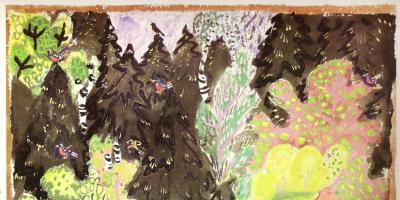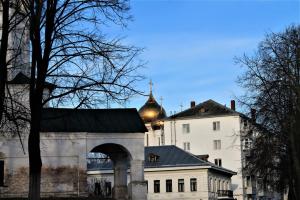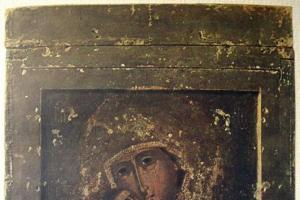Natalya Alekseevna Vasilyeva loved the work of Tatyana Mavrina very much and probably talked a lot about her to her students.
We cannot ignore this fact.
We cut the ribbon at the opening of the exhibition of this outstanding artist.
Suzdal. Bazaar.
Mavrina (Lebedeva) Tatyana Alekseevna (1900 - 1996). Painter, graphic artist. T. A. Mavrina spent her childhood in Nizhny Novgorod. There were four children, and they were raised as expected in intelligent families: reading and drawing, learning music and languages, attention to folklore and folk art, which seemed to surround and permeate their whole life. From these years, notebooks made by children in the Lebedev family have been preserved. It was a handwritten journal game. In 1921, Mavrina definitely chose fine arts - she entered VKHUTEMAS, where she studied with R.R. Falka, N.V. Sinezubova, G.V. Fedorov.
Later, the artist recalled this time as the happiest years of her life. After graduating from VKHUTEMAS in 1929, she joined the Group “13” association and became a participant in the association’s exhibitions. In the 1930s, Mavrina was engaged in painting, painted watercolors, and made drawings. Many of her works of this time are close to French post-impressionist movements. Mavrina’s last painting on canvas with oil paints was painted in the summer of 1942 (“Dancing on the veranda of the club”). Mavrina called what began after this picture her new life. After the war, the artist rediscovered the world of folk art. She not only loved and collected icons, clay toys, trays and embroideries - with her husband, artist N.V. Kuzmin, she put together a magnificent collection - Mavrina herself made copies of splints and spinning wheels, painted tueski, antique trays and bottles, and got used to the image of a folk craftsman. She created her own “Mavrinsky” style - decorative, dashing, based on the principles of folk primitiveness. In the 1950s and 60s, the artist made numerous trips to Russian cities, making sketches and sketches for future works. The favorite theme was nature, “earth and sky.” A special place in the artist’s work is occupied by her cheerful and always sunny illustrations for children’s books. Made, as always, in folk style, they perfectly suit the plots of Russian fairy tales. In the late 1980s, Mavrina almost never left her home. Despite illnesses and illnesses, she devoted herself to her passion - painting, painting views from the window, still lifes, flowers. Her works of recent years are so plastically convincing and carry such a powerful energy charge that Mavrina’s later work can rightfully be placed on a par with the paintings of the greatest masters of the 20th century. Tatyana Mavrina's works are kept in almost all the largest museums in our country, including the State Tretyakov Gallery, the State Russian Museum, the Saratov Art Museum and in private collections.

Abramtsevo

Rogachevskoe highway










From the series “Fairy Beasts” 


From the series “Silver Pond” 



From the series “Moscow” 




Mavrina was known and appreciated as a graphic artist and illustrator who embodied in her work many of the principles of Russian folk art, which she knew very well. Russian icons, popular prints, embroideries, and clay toys were of interest to her not only as collectibles, but also as examples of high artistic culture, a living language to which she turned. Her illustrations for children's books and Russian fairy tales, albums of drawings made while traveling in Russian cities aroused great interest and were rightfully considered part of Russian art of the 70-80s.

The artist was awarded the title of Honored Artist of the RSFSR, had awards and prizes, including the State Prize of the USSR.

And yet, as if an invisible wall separated her from official Soviet art. This “otherness” was felt by everyone - from the main artists of state publishing houses, who signed Mavrin’s books for publication with great reluctance, to the organizing committee of the international prize named after G.-H. Andersen, who chose Mavrina - practically the only Soviet children's book artist - as the winner of this prestigious award in the field of book graphics.

Tatyana Mavrina was born in 1900, although she herself always called the year of her birth 1902, and it was this incorrect date that was included in almost all reference books and biographies written during the artist’s lifetime. There was only one reason - female coquetry, the desire to appear a little younger. Her childhood was spent in Nizhny Novgorod, there were four children in the family, and they were raised as expected in intelligent families: reading and drawing, learning music and languages, attention to folklore and folk art, which seemed to surround and permeate her whole life. “The geography is fantastic from mountains, rivers, swamps, ravines, forests, all sorts of legends, old cities around: Suzdal, Vladimir, Yuryev Polsky, Murom, Gorodets, and there are picturesque folk crafts - Gorodets, Semenov, Khokhloma, Palekh, Mstera. The city is surrounded by folklore,” Mavrina recalled about her childhood feelings. From these years, notebooks made by children in the Lebedev family have been preserved. They contain poems and stories, drawings, watercolors. Playing with a handwritten journal awakened thought and creativity, giving rise to a feeling of the fullness of life, in which there was so much to comprehend and capture. From the fullness of childhood arose the feeling that “there is a lot of things around,” and this feeling will not leave T. A. Mavrina throughout her long life


In 1921, she definitely chose fine art - she entered the “fantastic university VKHUTEMAS” and became recklessly interested in painting. Mavrina later recalled this time as the happiest years of her life. The French impressionists in the Shchukin and Morozov galleries became a real school of painting for her. And the end of the 20s dates back to her membership in Group “13”, participation in joint exhibitions and the search for her place in art.
 Self-portrait
Self-portrait
But after the twenties came the thirties, and with them the dictates of the permitted path in art. During this tragic time for the whole country, Mavrina remained faithful to painting. In the spirit of the international pictorial tradition, the artists of Group 13 collectively hired a model.

Mavrina said that an artist equal in strength to Titian cannot be found among the Impressionists, but “all together the Impressionists will outshine. They rediscovered the world of ideal harmony and everyday life.” Many of her works of this time are close to French post-impressionist movements. One of the paintings, painted in shining mother-of-pearl tones, is called “Imitation of Renoir” (1938).

Imitation of Renoir
Almost every day she painted or drew a nude female model, working in a variety of techniques. Imitations of Henri Matisse were replaced by life sketches in the women's bathhouse. Venuses in front of the mirror existed next to undressing women in underwear of that unforgettable blue color, which was characteristic of knitwear during the “building of communist society.” From this time there remained many drawings and watercolors, several dozen canvases, which were kept literally under the bed for many years - the artist did not show them to anyone: after all, nudity was an unlawful, almost forbidden topic.
 Only in the 70s, some of Mavrin’s “nyushki” (as she called them in a popular manner, playing on the French “nude”) began to appear at exhibitions, striking with their joyful life affirmation and raising the question: “Is it possible that an artist of the 20th century, having isolated himself from those around him, persistently praising the joy of being at a time when one of the cruelest tyrannies reigned?” Apparently, Mavrina allowed herself not to notice her, which was a desperate and decisive opposition to the general atmosphere of depression or hysteria.
Only in the 70s, some of Mavrin’s “nyushki” (as she called them in a popular manner, playing on the French “nude”) began to appear at exhibitions, striking with their joyful life affirmation and raising the question: “Is it possible that an artist of the 20th century, having isolated himself from those around him, persistently praising the joy of being at a time when one of the cruelest tyrannies reigned?” Apparently, Mavrina allowed herself not to notice her, which was a desperate and decisive opposition to the general atmosphere of depression or hysteria.

The last painting on canvas with oil paints was painted in the summer of 1942 in the garden of the Red Army House and depicted dancing on the veranda of the club. Mavrina called what began after this picture her new life.

After the war, the artist rediscovered the world of folk art. She not only loved and collected icons, clay toys, trays and embroideries - with her husband, artist Nikolai Vasilyevich Kuzmin, she assembled a magnificent collection - Mavrina herself made copies of splints and spinning wheels, painted tueski, ancient-shaped trays and bottles, got used to the image of the folk masters This was a brilliant move, it gave her the opportunity to move away from the principle of socialist realism with its illustrative everyday life in the only direction allowed at that time - towards Russian folk art. Henri Matisse acquired his own style through his passion for folk art, and Tatyana Mavrina, starting from Matisse, turns herself into a folk artist, creating her own “Mavrinsky” style - decorative, dashing, based on the principles of folk primitiveness.

For the artist’s creativity, natural impressions were necessary. In the 1950-1960s, she made numerous trips to Russian cities, making sketches and drawings.

She trained her memory and her eye so much that at home she could easily reproduce the many colors of nature from hasty sketches made from life.

Animaisa Vladimirovna Mironova, her frequent confidante on these trips, recalls how at the very beginning of the 60s, in early spring, during a flood, she and Mavrina ended up in a small God-forsaken hotel. Early in the morning A.V. Mironova woke up and was surprised to find that Mavrina was not in the room. It turned out that Tatyana Alekseevna managed to persuade the fisherman, and on a fragile little boat in the middle of the Volga flood, she enthusiastically painted the sunrise. The artist’s words that “earth and sky became the theme of landscapes and books” accurately express the essence of her work of these years.

Tatyana Alekseevna Mavrina in her autobiography divided her life, as she put it, into “three lives”: the first - “from birth to VKHUTEMAS”, the second - Moscow, studying painting with Robert Falk, passion for the impressionists, participation in exhibitions of the Group “13”, third - began during the war. But there was also a fourth - the last decade of life.

At the end of the 1980s, Tatyana Alekseevna almost never left her home. The world has closed itself within the walls of a small apartment, covered with Mavrina’s favorite gold and silver paper. Those who happened to visit her house were amazed at the incredible inner strength that emanated from the thin ninety-year-old woman. This will to live seemed to protect her from the infirmities of old age - she saw practically without glasses, was in a clear mind, and even if she forgot something, it was never possible to say for sure whether it was forgetfulness or cunning.

Despite illnesses and illnesses, Mavrina devoted herself to her passion - painting - and painted still lifes as if she contained in them the inescapable power of her frantic nature. Her two windows - from one you can see a birch tree, from the other - a tree and a garage - became her Universe, through them she observed the change of lighting, the alternation of seasons, the rotation of the stars.


The artist asked to bring her flowers and, having received a bouquet as a gift, no longer hid her desire to quickly see the guest out and get to work. This is how daffodils appeared against a background of pink birches, tulips on a snow-covered window, and a beautiful pink gladiolus in the blue summer. It would seem that what could be simpler than the image of an ordinary bouquet on the windowsill?





However, these works are so plastically convincing and carry such a powerful energy charge that Mavrina’s later work can rightfully be placed on a par with the paintings of Raoul Dufy and Henri Matisse. And one of the last still lifes, “Roses at Night” (1995), - wine-red flowers on a windowsill against a blue sky with the shining constellation Orion - can be called a tragic requiem before the inevitable departure into oblivion.

“Did time stand still or go backwards” - these lines from Rilke, familiar to us in Pasternak’s translation, begin Mavrina’s autobiography. The epigraph was not chosen by chance, just as there was nothing accidental in the fate of Tatyana Alekseevna. “Standing time” is the feeling that amazes you when looking at Mavrin’s late still lifes. The life-affirming power and color plastic energy of these works evoke associations not only with the art of the beginning of the century, but also with the creativity of a young man full of strength. Almost always, after the death of an artist, the significance of his work is overestimated. Often it begins to fade, “shrinks” and fades, to eventually turn into a line in a special edition. Much less often, death transforms ordinary epithets into sublime ones, and the word “brilliant,” which they were embarrassed to say during life, becomes just right. This seems to be what happened to Tatyana Alekseevna Mavrina.
Tatyana Alekseevna Mavrina generously showed her talent in various creative directions. She created series of sketches dedicated to ancient Russian cities, sketches of scenery and costumes for theatrical performances, and a number of cartoons. A special place in her work was occupied by illustrating books for children. The most famous is the design of A. S. Pushkin’s fairy tales: “The Tale of the Dead Princess and the Seven Knights,” “Ruslan and Lyudmila,” “Fairy Tales,” as well as the collections “At the Command of the Pike,” “Russian Fairy Tales,” “To Far Far Away Lands.” T. A. Mavrina also acted as an illustrator of her own books: “Fairytale Animals”, “Gingerbread is baked, but the cat does not fall into the paws”, “Fairytale ABC”.
Turning to the traditions of folk art and the national origins of fairy tales helped T. A. Mavrina develop a sense of decorativeness, become a singer of Russian fairy tales, and combine fantasy with the surrounding life in plastic, visible images.
The unique “Mavrinsky style” is based on the principles and forms of works of folk art: silhouette composition, bright colors, multi-tiered development of the plot, etc.
Lightness, freedom and ease of drawing, grace of lines, richness of color, subtlety of color relationships, strict selection of means, the seeming childishness of the image are inherent in the illustrations of T. A. Mavrina, splashing with gaiety and energy.
The coloring of T. A. Mavrina’s books is closely related to the color formulas of folk art developed over centuries. The color background of her sheets is densely populated with spots of different sizes and shapes; the image is not readable against this background, but grows out of it. The color harmony of her books sounds like a polyphonic roll call of similar color motifs (“Choose any horse”) or is built on the principle of bold color contrasts (“Fairytale Animals”). The artist boldly generalizes the form and strives for a bright, major sound of her works.
One of the first books illustrated by T. A. Mavrina was “The Tale of the Dead Princess and the Seven Knights.” His passion for A.S. Pushkin remained throughout his life. Graceful letters, headpieces, decorations, naturally combined with plot illustrations, give the book design integrity and stylistic unity that corresponds to the poetic integrity of A. S. Pushkin’s fairy tales.
Of great importance in the work of T. A. Mavrina, an illustrator of fairy tales, is her careful study of ancient Russian architecture. Depicting the ensembles of Sergiev Posad, Pereslavl-Zalessky, Moscow, Rostov the Great and other cities, the artist finds a special color key in each sheet, conveying the national features of rich, patterned, strictly harmonious ancient Russian architecture.
The most important feature of T. A. Mavrina’s art is the connection between the poetry of fairy tales and the plastic beauty of various types of folk arts and crafts. In the elegant colorfulness of the illustrations you can see the charm of folk clay toys, Russian lubok, household ceramics, gingerbread, tiles, and ancient costumes. The work of T. A. Mavrina helps to reveal the inexhaustible wealth of folk aesthetics and to experience the national basis of folklore.
Best of the day
Visited:618 |
The first producer of the Soviet Union |
“Seeing the same beauty that was three hundred years ago”
Forgotten artist Tatyana Mavrina is 115 years old
Fantastic animals and “non-Soviet” landscapes, simple ancient cities and ironic portraits - 115 years ago the only Russian artist who received the international Andersen Prize was born, Tatyana Mavrina. More books and paintings and
Tatiana Mavrina. "Glass Pond"
Tatyana Alekseevna Mavrina - an atypical Soviet artist, a famous illustrator and graphic master - during her lifetime she received the USSR State Prize (1975), the title of Honored Artist of the RSFSR (1981), and her most important award - the International Andersen Prize (1976) for her work in children's illustrations. Mavrina is the only Russian artist in the history of the prestigious award to receive a medal. She could easily be put on a par with Vasnetsov and Bilibin, but despite her talent and recognition, the artist’s works were not included in the official catalogs of Soviet painting. Either Mavrina’s style was too bright for the gray domestic reality, or her love for the impressionists got in the way. Meanwhile, the artist’s works are kept in the main Russian museums, including the Russian Museum in St. Petersburg and the Moscow Pushkin Museum named after A.S. Pushkin.
___
Tatyana Mavrina was born in Nizhny Novgorod into the Lebedev family. Her father is a teacher and writer, her mother, a hereditary noblewoman, is the director of the Nizhny Novgorod Gatsissky School, and her brother Sergei is an academician, the founder of Soviet cybernetics and the creator of the first Soviet computer. According to some sources, the year of birth of the artist is 1900, according to others - 1902 - this is the date she indicated in all questionnaires. They say that Mavrina attributed the extra two years to herself for some reason.
The family ended up in Moscow during the hungry years of the Civil War.
The artist acquired the pseudonym Mavrina (her mother’s last name is “Gazeta.Ru”) after graduating from the legendary Vkhutemas, where her mentor was Robert Falk.
“In 1929, I graduated from a fantastic university - Vkhutemas, that is, the Higher Art Technical Workshops. It’s even more correct to decipher the first word - not Higher, but Free. It was free and spacious there, despite the irrepressible, hot hubbub - deserted... And you could drive through this desert in any direction. By the will of the wind or by one’s own will,” Mavrina wrote in her book “Rejoicing Color.”
At this time, she discovered the Impressionists and Post-Impressionists and became an ardent follower of Monet, Renoir, Van Gogh, Cezanne, Bonnard, Matisse, and Picasso.
“...After the Impressionists and Van Gogh and Matisse, the earth was transformed in the eyes of people and became breathtaking! They showed how to look, and what you see is up to you,” the artist recalled.
In the same 1929, she joined the group “13” - she participated in joint exhibitions, experimented with nude portraits, imitated Renoir and Matisse, and searched for herself. Many works of this period remained unknown to the Soviet audience - in the country of victorious socialism, the depiction of nudity was condemned.
“1941! The war changed life. The theme was the street. On the last canvas I painted blue collars of sailors with girls on the dance floor at the CDKA. I could no longer paint in oils: I had no time, nothing to use and nothing to use, so I switched to pencil drawings in a notebook,” the artist wrote in the early 40s.

Tatiana Mavrina. "Fairy Beasts"
After the war, Mavrina plunged headlong into folk art, “hiding” behind its decorations, like the writer Yuri Koval, whose books she also illustrated, in children’s literature. Mavrin’s images are recognizable, and anyone who at least once in childhood held a book with illustrations by the artist will easily remember, even without knowing the name of the author, her fairy-tale cats, roosters, bears, epic heroes and popular print beauties from Russian fairy tales and the works of Pushkin.
The artist found bright and juicy, naive, folk and in many ways ancient Russian subjects in her numerous trips to ancient Russian cities, including Zagorsk (Sergiev Posad - Gazeta.Ru), Uglich, Rostov the Great, Alexandrov, Suzdal, Pereslavl-Zalessky and other.
“When we lived in Zagorsk for the summer, it was as if I met my childhood - with Gorodets painting; for the second time I fell in love with her festive attire and understood with my Nizhny Novgorod memory how it was possible to look at everything around me in a different way, not like VKHUTEMAS, with the cheerful eyes of Trans-Volga artisans;
to depict not still lifes, but life itself, how it flows and will flow away without a trace if you don’t sketch it, the artist wrote in her book. -...I wanted to see the same beauty that was a hundred, two hundred, three hundred years ago. And in the 18th century there could be a bright pink scarf on a woman or a bouquet of flowers on a gingerbread-pink tower, pink on pink; or a cart with hay stops, where the horse is not visible at all, it is pasted into green ocher, and the peasant’s only leg is visible in the snow, and the other one, who is on the cart, has one hand, a gesture of some kind of order, in the lilac sky.
In total, Mavrina designed more than 200 books.
Carvings on windows, ornaments, tiles, spinning wheels, birch bark tues and gingerbread boards - Mavrina was interested in any folklore detail. Together with her husband, artist Nikolai Kuzmin, she collected a unique collection of icons, clay toys, trays and embroideries.
“When I think about Gorodets beyond the Volga, the following always pops up: “The Volga was coming...” - although these lines by Nekrasov have nothing to do with Gorodets. Old Gorodets painting on wooden village things, most of all on the seats of spinning wheels - bottoms, preserved, so to speak, precisely this unhurried pace of movement of the big river,” Mavrina recalled.

Tatiana Mavrina. “Trinity Gate of the Kremlin” (1946)
Mavrina the graphic artist remained in the shadow of Mavrina the illustrator. Few people know that she began painting Moscow in ink during the war - her works from the “Moscow” series remembered a city that no longer exists.
“I didn’t find my new topic right away. Once, driving along Sretenka, from the bus window I saw a 17th-century church hidden among houses and fences. ...The bell tower was no longer there, and the church could have been destroyed by bombing. How can I help beauty? I must quickly sketch everything that has been preserved in Moscow, I thought, at least let it remain on paper. ...I began to walk around Moscow almost every day and slowly draw. ...I walked all possible streets, distant lands, often on foot,” Mavrina recalled.
At the end of her life, still lifes became the artist's main passion.
She was sick a lot, almost never left her small apartment and was very happy when one of the guests brought flowers, which the 90-year-old woman painted every time with enviable persistence. It was the flowers against the background of a birch tree and a garage - the only thing Mavrina saw from her windows - that became the main characters of her latest paintings.
Fairytale animals by Mavrina
___
Russian artist Mavrina Tatyana Alekseevna
___
In the Bookcase, I talked about the texts of books, then in the next two the names of the authors speak about the texts. These are fairy tales by Alexander Sergeevich Pushkin and Hans Christian Andersen.
So I'll talk about illustrations. Pushkin's fairy tales were illustrated by a huge number of artists, in different manners and techniques, from palekh to oil painting, at different times and sometimes more than once. And recently, the Nigma publishing house gave us a magnificent book with drawings by Tatyana Mavrina. She is the only Russian illustrator to receive the most prestigious international award in the field of children's literature - the Andersen Prize. “The Tale of the Dead Princess” and “The Tale of Tsar Saltan” in this version have not been republished for more than 70 years, so we are incredibly lucky.Mavrina illustrated Pushkin all her life.This edition features early works that are detailed and realistic, with pure, joyful colors that make you dive into the sea. This is exactly how I remember them from childhood, which is probably why I love them more. ( The later ones can be compared in the publication "Lukomorye. Fairy-tale worlds of Tatiana Mavrina" from Moscow textbooks).
“If there are such miracles in words, then what kind of illustrations should there be?” All life Tatyana Mavrina I answered this question with drawings." And, I must say, she answered perfectly.




















The quality of the publication is excellent - large format, hard original cover, thick matte coated paper, convenient font. The book completely preserves the author's layout of Tatyana Mavrina, with all the initial letters, ornaments and text layout in several columns(only the title page, foretitle and table of contents have been changed, since two books are collected under one cover) . Thanks to the wide margins, the publication breathes and glows. The only regrettable thing is the lost princess on the frontispiece and the thickness of the collection - two tales, and introductory article by Oksana Vasiliadi about the artist. As for the rest - I am happy - I couldn’t be happier.
“It used to be that there were no two scarier things: first, departing trains in different directions; the second is the impossibility of drawing what you see,” 75-year-old Tatyana Alekseevna Mavrina (1900–1996) wrote in her diary. This phrase alone allows you to feel the sharpness and originality of perception that distinguished this woman.
Here is a book that includes diaries and essays of one of the most brilliant and original artists of Russia of the 20th century. Tatyana Alekseevna lived a long life, perhaps not very rich in external events, but extremely emotionally rich. Her inner life consisted mainly in the service of painting - in creating a joyful hymn to earthly existence and the beauty of the world. “To put her admiration for life on paper with paints” - this, in fact, was the goal that the artist set for herself, which gave her strength and filled her daily activities with meaning.
We had diary entries that Mavrina had kept since the 1930s, in some years very briefly, and in recent decades almost daily, with a lot of everyday details. Over time, both the form and nature of these diaries changed. Business records, financial notes, travel “reports” on trips are interspersed in them with descriptions of everyday life, sometimes very frank, sometimes ironic, or with observations of nature during walks...
Separately, the artist wrote down “for memory and reading” thoughts about art, impressions of exhibitions, made many extracts from the literature she read, and her reading range was extremely wide and varied - literary novelties, memoirs, materials on history. These are Russian writers - Pushkin, Tolstoy, Dostoevsky, Turgenev, and Western classics - Hoffmann, Balzac, Merimee, Hermann Hesse, Maugham, Warren, and philosophers - Socrates (“Socrates struck me to the very heart”), Kant. In the 1960s, Mavrina read Sartre with enthusiasm and wrote in her diary: “I find similarities in the issue of work and death with my ideas.” Her assessments are unexpected and difficult to predict. She loved poetry, wrote down poems by N. Gumilyov, V. Khlebnikov, Lorca, Rilke in translations by B. Pasternak. She knew the work of A. Blok very well. The cycles of her landscape sketches and gouaches from the late 1970s - early 1980s are dedicated to Blokov’s places in the Moscow region, on the basis of which the book “Geese, Swans and Cranes” was later made. Mavrina was interested in literature about Pushkin professionally, because she made illustrations for the poet’s fairy tales.
The artist did not often turn to art historical literature, making an exception for the books of her good friend N. A. Dmitrieva (the author of the text for Mavrina’s album). But I read a lot of research about Russian folk art, about ancient Russian painting, about folklore, about fairy tales, proverbs, conspiracies; that is, in her words, “I was engaged studying one's nationality." The artist knew and corresponded with major historians and art critics - A. Rybakov, D. Likhachev, A. Vasilenko, A. Reformatsky, I. Grabar, N. N. Pomerantsev, and constantly communicated with employees of Moscow museums.
In the mid-1930s, Tatyana Alekseevna and her husband, artist Nikolai Vasilyevich Kuzmin, began collecting icons and objects of decorative and applied art. Most of this collection is now in the State Museum of Fine Arts named after A. S. Pushkin, in the department of personal collections. Separate gifts were made to the State Tretyakov Gallery, including the 16th-century icon “Don’t Weep,” and to the A. S. Pushkin Museum. Mavrina told the history of the collection in the article “On Old Russian Painting,” which is published for the first time in Russian in this edition.
Tatyana Alekseevna began keeping a diary at a particularly happy time for her - in the summer of 1937, when she and Nikolai Vasilyevich spent the first summer of their life together in Gribanov, near Moscow. Subsequently, recordings were made “out of excess strength” and when everything was going relatively calmly. When trouble came, on days of illness - hers or her husband's - records became meager or were not kept at all.
We divided the diaries chronologically into 4 sections. First section - 1930–1940s- almost completely reproduces one notebook, the earliest and most voluminous (Mavrina called it “Chronicle”). It contains summary, almost encrypted records - one per year - from 1930 to 1936. And from 1937 to 1943 the diary was kept in more detail. For 1944 - only one entry. From 1945 to 1958, no records were kept, or at least none could be found.
Second section - 1960s- starts in May 1959. This is the most information-rich, most dynamic part of Mavrina’s diaries. Tatyana Alekseevna is full of strength and energy, she leads an active lifestyle, travels, “fights” with publishers, writes down interesting observations and funny episodes. This section presents entries from various notebooks and notebooks in chronological order.
By the end of the 1960s, a special type of Mavrin’s diary was taking shape: on the sheet on the left were extracts, sometimes very voluminous, covering several pages, from what she was reading at that moment, and on the right she placed diary entries. Thus, the structure of the diary to a certain extent revealed a picture of the artist’s life, in which there were, as it were, two parallel streams - everyday life, with all the events, people, publications - and inner life, filled with creative searches. Sometimes, among extracts from what she read, her polemical comments are found.
Section dedicated to 1970s(only 1972 is missing from the records of this period) is a chronicle of Mavrina’s intensive work in a children’s book with serious ideological “battles” that played out in publishing houses between supporters and opponents of folk art. When you read this section, it’s hard to believe that the author of the text is over 70; so much energy and vitality is felt in these lines.
1980–1990s- the last section of the diaries. During this period, Tatyana Alekseevna’s relatives passed away. She is increasingly concerned about classical music, which she listens to on the radio, she believes in dreams more and more, memories, sensations, and premonitions are becoming increasingly important in her life. In her notes there are amazing lines that reflect the extraordinary strength of spirit of the artist, who is already over 80: “I walked alone for almost a kilometer and talked out loud to the trees and clouds. Something like this simply: “You, blue sky, and black fir trees, and brown birches. I love you. I admire you, I’m happy about it.”
The reader will certainly pay attention to the imagery and richness of her language. Expressions such as “it got wet” (about a rainy summer) or “the artist is sometimes thundering, but more often crawling” (about visiting Kustodiev’s exhibition) are not only remembered, but seem to “stick” to what is being described.
The charm of Mavrina's style is one of the criteria that determined the abbreviations of diary entries necessary for publication. Other criteria were information content and connection with creativity. Everything that, in our opinion, might be of interest to an art historian and researcher of the artist’s work was included in the publication. Even small details, for example: “I paint with new German tempera 700 paints. It looks like gouache. The tones are good ultramarine.”
Color is the basis of the artist’s vision, her language, a way to express “delight of the eyes.” “Hurt by color,” she says to herself more than once. How exactly the creative process developed, how the artist managed, in her words, “to draw beauty out of chaos” - this question always intrigues the reader. And although Mavrina rarely and sparingly reveals her professional secrets and techniques, reading her diaries, one can clearly imagine how she worked from the late 1950s to the end of the 1980s: the first stage is sketches from life that Mavrina made during during long and “short” trips, I marked in a notebook where what color would be applied. Then, at home, from memory, gouaches were made from these sketches. The artist developed her visual memory so that she could create large compositions, sometimes several weeks after the trip. She painted quickly, usually in one session, and rarely completed the painting the next day. And after some time, looking at the compositions, she “gave” herself grades: from one to three crosses, three crosses - the highest score. In addition, she worked at home almost every day, from nature - she painted still lifes, sometimes portraits. Often her compositions included fragments of icons from the collection. Since the late 1980s, Mavrina painted mainly only still lifes with flowers on the window; these later works are distinguished by their unusually expressive sound of color.








